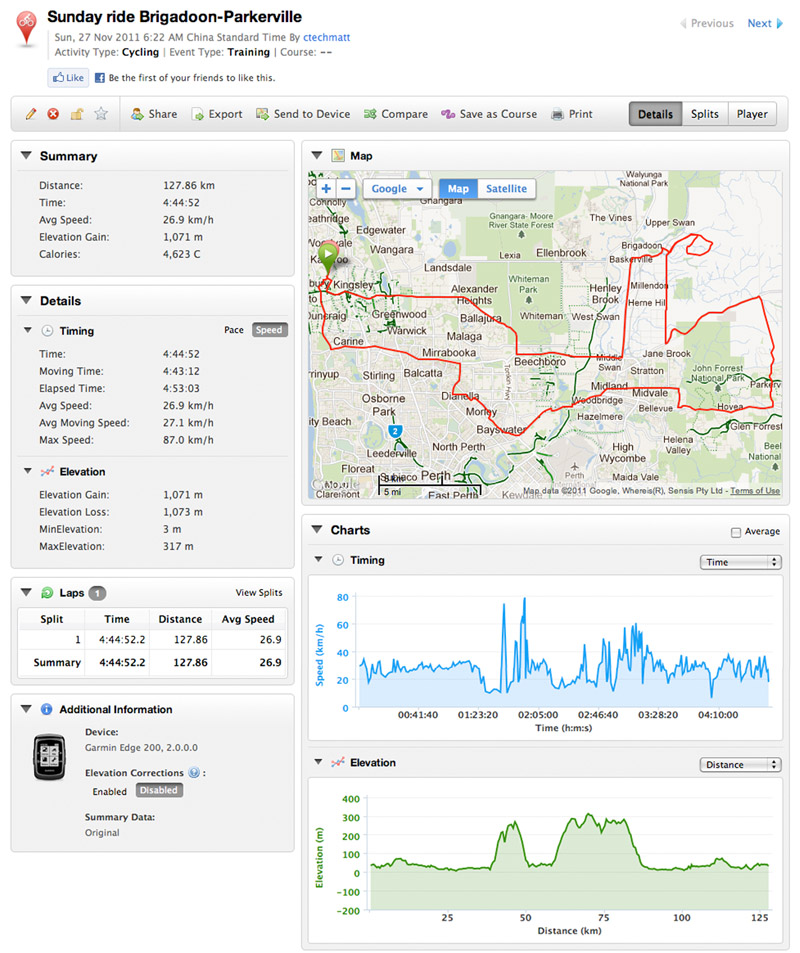The Global Positioning System was invented and developed for military purposes by U.S. defence forces about 40 years ago. The system comprises a network of satellites that transmit precisely timed signals that ground receivers, such as the Edge 200, can use to calculate their position on the planet. The military has enjoyed high resolution GPS since the late-1980s, but rather than protect the technology, revisions to U.S. legislation by Presidents Reagan, Clinton and Bush have granted civilians increasing access to the system. Their hope was that GPS would serve the greater good of mankind, and so the system is available to serve the humble bike rider.
The Edge 200
Within moments of being turned on for the first time, the Edge 200 is ready to provide all the standard functions offered by a bike computer i.e. speed, distance, and average speed. However, there is no need to install a magnet on a spoke or determine wheel circumference, the Edge 200 uses GPS to work it all out.
What’s in the box?
Aside from the main unit, the Edge 200 comes with two mounting brackets, a stack of o-rings for securing the brackets, and a combined USB cable and AC adapter for data download and battery charging. There’s also a brief instruction manual. The only other thing you’ll need to make full use of the Edge 200 is a computer with an internet connection so that you can set up a free account with Garmin Connect to upload and share your ride data. For those of you with clear training goals, then you’ll probably find that Strava is better suited to your needs.
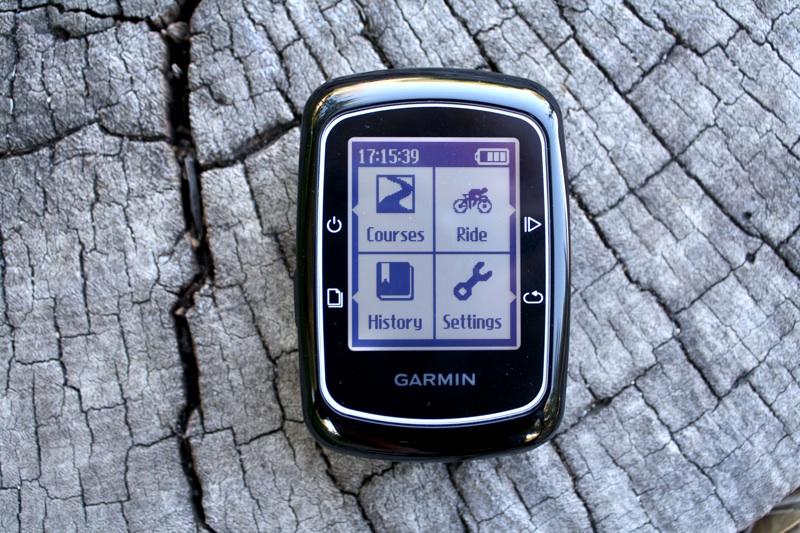
This is the main menu screen where you can select to view or use a course, start recording a ride, review your past rides in your history, or fiddle with the unit's settings. The unit has four buttons, two on each side, that serve multiple functions, depending on your menu choice. At each screen, each button is labelled clearly and the unit's menus are very easy to use.
Setting up the Edge 200
The first job is to charge the main unit. My unit was already 50% charged straight out of the box, so I dived right in. With the power on for the first time, there were a few questions to answer on language preference and clock format, plus my age, weight and height, then I had to go outside so the unit could locate a GPS signal. Within 60 seconds, the Edge 200 was ready for use. And there was no need to set the clock; GPS took care of that too.
Fitting the unit to my bike was dead easy. All I had to do was find a spot on the bars or stem, and stretch two o-rings to secure the bracket. The main unit requires a 90° twist to mount it in the bracket, so you’ll need to leave a bit of room to fit it lengthways.
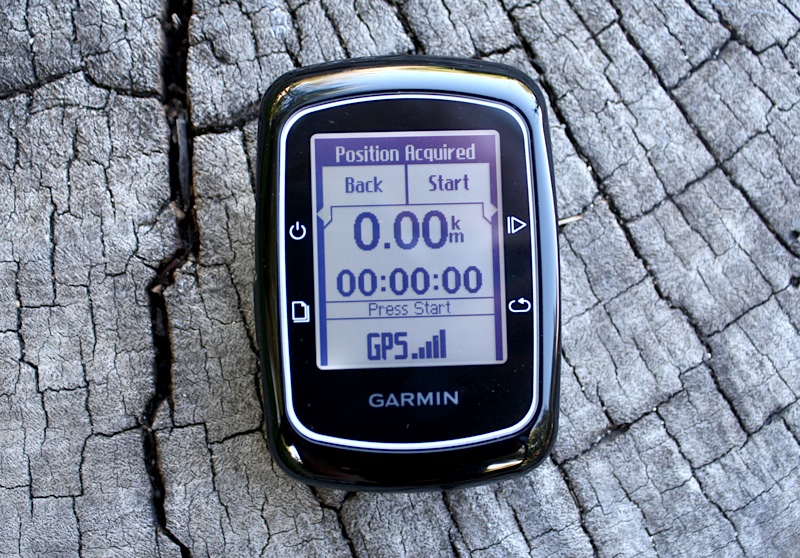
Moments out of the box and the Edge 200 is ready to track your motion, be it on the bike, in the car, or on a flying fox. Once the unit has acquired a GPS signal, as shown, just hit the start button to record your progress.
Using the Edge 200
The Edge 200 essentially operates as a recorder. You can either press the start button before you set off, or the unit will prompt you to start recording when it detects motion. Once recording, the unit will display your current speed, time elapsed, and average speed. At the end of the ride, you then have the option to save or discard the data.
The Edge 200 can record at least 130 hours worth of riding, which should accommodate even the hardest riders for at least a month. All saved data is accessed via the History menu where you can look up the time elapsed, distance travelled, average speed, maximum speed, total ascent and descent, and estimated calories for each ride just like a regular bike computer. However, by uploading the ride to Garmin Connect or Strava, you will get access to data that a standard bike computer can’t provide: a map of your ride route and a display of your speed and altitude changes over the entire course of the ride. Very cool, if only because you can annoy loved ones with lots of data (and graphs!) when they ask where you went riding.
Split times
The Edge 200 easily records split times during a ride, all you have to do is press the lap button. Alternatively, the unit can be set up to measure split times at regular intervals (eg every 10 minutes or every 5km). I found the manual split times very handy for climbs and intervals, and I could view the splits on the main unit (in ride history) or after uploading the ride.
Courses
Strictly speaking, you can’t think of the Edge 200 as a navigating device, it doesn’t have any maps, but it can provide you with directions. The “return to start” feature can be activated at any point during a ride, and a squiggle (representing the course back to where you started recording the ride) replaces the data screen and an arrow points you in the right direction. It won’t help you find the quickest way home, but it will accurately show you the way you’ve come. Keep in mind that no street names or landmarks are displayed, though north is shown to help your orientation.
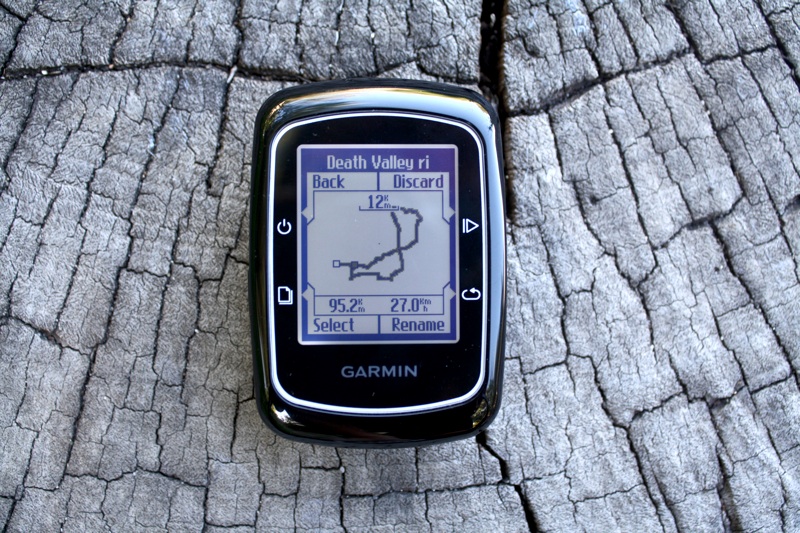
Here's a look at what a course looks like on the main unit. Note the scale near the top of the screen and the calculated distance for the ride at the bottom. When in use, the scale collapses to show 80m of the road ahead with arrow to show where to go.
Another way to navigate with the Edge 200 is to load the course information from a previous ride. This function is accessed via the courses menu on the main screen and, like “return to start”, a squiggle and arrow direct you along the path of the ride. As you follow the course, the unit will display how much of the ride you have completed and the distance remaining. The Edge 200 also becomes something of a race commentator as it compares your time to the course time and provides splits throughout the ride, even congratulating you at the end if you finish with a better time (“You win” flashes on the screen). If you deviate from the course at any point, the unit will alert you and an arrow will show you how to find the route again, but you’re free to re-join the course at any point. The Edge 200 appears to update its directions based on the shortest distance back to the course.
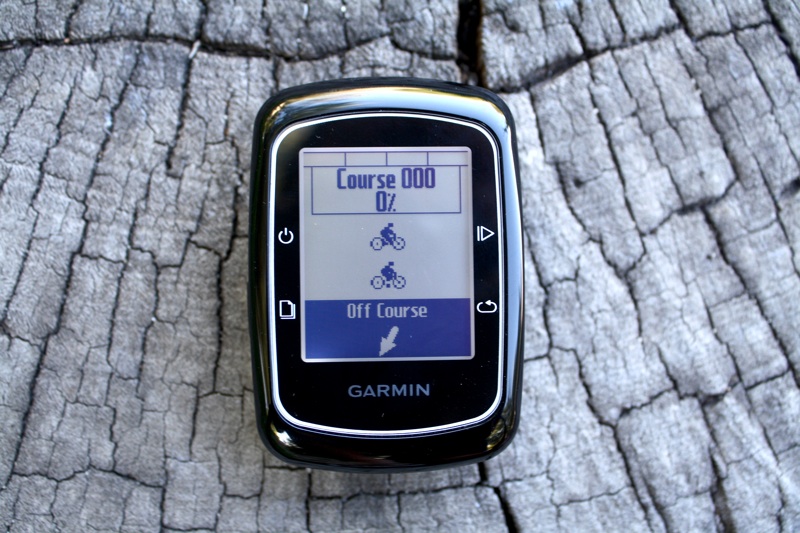
Here's a peek at the Edge 200 commentary team. As you gain or lose time, the bikes separate, where you're current time is represented by the lower rider, while the upper rider is the course time. When you stray from the course, you'll get the message shown on the lower part of the screen. The unit also scrolls through the time and distance in the lower part of the screen.
The value of the Courses feature increases several-fold once you start sharing or creating courses via Garmin Connect. You can search all rides that have been uploaded and shared for a region and download the courses that take your fancy. Alternatively, you can create a course by manually plotting your ride on a map. This is a great feature of the Garmin Connect site, just pick a start point and click on the roads you want to use and it will show you the distance as you design the course, plus you can program an average speed, which will then be used by the Edge 200 commentary team to mark your progress as you ride the course. My only grumble is the map provided for Western Australia was a year old and lacked a few new roads. Regardless, the courses feature allows you to do away with a map when venturing out on unfamiliar roads anywhere on the planet.
Other Features
Riding in the rain shouldn’t be a problem for the Edge 200 because it has been built to withstand “immersion in 1 meter of water for 30 minutes”. I didn’t test the validity of this claim, but I can report that the unit was untroubled by one hour of rain.
Like many other bike computers, the Edge 200 can be set to pause when you stop moving, so traffic lights won’t interfere with your average speed. The unit will also turn itself off after you stop recording a ride to conserve power. If you forget to stop recording, then ride will remain paused and the unit will stay on until you start or stop recording, or the battery discharges. The Edge 200 benefits from a backlit screen, perfect for early morning rides in winter or a late commute home. It’ll draw down the battery a little quicker, but the level and duration of backlighting is easily adjusted, or turned off, when you don’t need it.
Another nice feature is auto scroll, where the unit will scroll through the pages of data available. When you’re just using the unit to record your progress, auto scroll flicks through average speed, cumulative ascension, and calories at the bottom of the main data screen. When you’re using a course or “return to start”, the auto scroll will flick through the main data, map and commentary screens, and at any point, you can manually page through the screens with the pages button. In addition, there are three auto scroll speeds to choose from.
Limitations
The Edge 200 differs from its higher-priced siblings in that you cannot connect any other devices (i.e. no ANT+ support) . That means no power, cadence, or heart rate measurements can be collected. Also keep in mind that you have to actually move in order for the Edge 200 to provide speed and distance, which means it is completely useless for home trainers. The run time on a fully charged battery is around 14 hours, time enough for a long day of riding, but you’ll have to remember the charger when travelling. This might be an issue if you’re headed into the bush or away from power points, though Garmin sells an external power source that includes both a battery and a solar panel to address this issue. Finally, the battery cannot be replaced, so once you’ve depleted its charging cycles, the whole unit ends up in the bin.
Final thoughts
The simplicity of the Edge 200 makes for a tempting buy, it’s the perfect bike computer for anyone that has trouble programming a VCR however the device requires regular charging, which undermines its simplicity to some extent. For the price though ($149), you get a cordless bike computer, an altimeter, plus ride-mapping that you can share with your friends that have paid more for their GPS devices. I had no use for the calories measurement and would have liked a larger clock display on the main screen, but everything else seemed to be spot on. For me, the true test of any new gadget is that it performs a valuable function, and by offering some navigation functions, the Edge 200 has earned a permanent spot on my handlebars.

